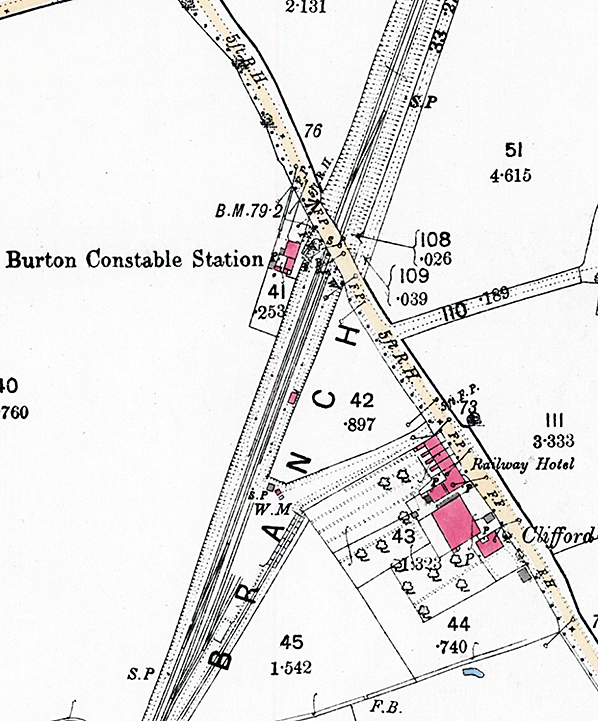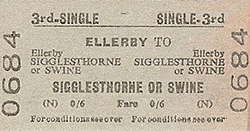
Station Name: ELLERBY (2nd station)[Source:
Mark Dyson]
.
1965old2.jpg) Looking north-east towards Ellerby station in the 1950s or early 1960s. Ellerby signal box is seen at the south end of the up platform. This controlled access to the goods yard which was sited to the south of the station (see map below).
Copyright photo by Jim Sedgwick  
1891 1:2,500 OS map. The layout of Burton Constable station is clearly seen. There are two facing platforms in the cutting with the down platform overlooked by the stationmaster's house. It is likely that tickets were issued from an office in the house. One building is shown on the up platform with no other platform buildings. There is no obvious access point to the platforms. No signal box is shown at this time. The goods yard is to the south of the station on the up side. Four sidings are shown, that to the right appears to be for coal. Access to the goods yard is along from Marton Road alongside a terrace of railway cottages with a weighbridge (WM) shown at the end of the access road. The Railway Hotel is seen at the south end of the terrace.

1927 1:2,500 OS map. A number of buildings have been added to the station including waiting shelters on both platforms and a toilet on the up platform. A signal box has also now been provided at the south end of the up platform. Some of the sidings have been relaid with a short siding now running end on to the dock. The crossover to the north of the station has been removed.
old1.jpg) Looking north-east along the up platform at Ellerby. Facilities at Ellerby were basic. There is a waiting shelter on the down platform with a similar shelter on the up platform. The single storey brick building is may have been the booking office although this is more likely to have been in the station house. There is also a toilet behind the photographer. Access to the platform was down a ramp from the bridge, this is out of view behind the shelter. A ramp to the down platform can just be made out to the left
of the signal. Copyright photo from Stations UK 1965old3.jpg)
On 3 May 1965 the final goods train from Hornsea Bridge passes through Ellerby station on its way back to Hull. Hornsea Bridge, the penultimate station on the branch, was the location of the town's goods facilities. The train is quite lengthy and was probably partly revenue earning and partly collecting any empties which had lingered on the branch. Ellerby had closed to all traffic by the date of this photograph. The locomotive is an LMS designed shunter of what became Class 11. Hull Dairycoates shed acquired a batch of these shunters new in 1952 but they soon moved to Springhead. When Springhead closed in 1961 the majority were moved elsewhere but No.12122 remained in Hull, returning to Dairycoates and here she is being photographed at Ellerby. She was later transferred to Immingham from where she was withdrawn in 1971 but that was not the end for she served in industrial use until 1985 when the scrapyard finally beckoned. Class 11 was developed into the ubiquitous Class 08 but there were a number of differences not immediately obvious to the untrained eye. One of these was Class 11 never being fitted with train brakes and this may account for the presence at Ellerby of two brake vans. Interestingly Dairycoates shed acquired a number of Class 14 diesel-hydraulics which the Western Region did not know what to do with. Some had already arrived when this photograph was taken and the job No.12122 is performing was the type of work the Class 14's were intended for but whether any made it onto the Hornsea branch is not known for they performed little, if indeed any, work around Hull before being disposed of.
Photo by Arthur Robson 2.jpg)
Ellerby
station looking north-east in May 1975.
11.jpg) Ellerby station looking north-east towards Hornsea from the south end of the up platform in April 1976.
Photo by Alan Young 6.jpg)
1.jpg)
The
platforms and station house looking north-east towards Hornsea in March 1991. The bridge
at the far end of the platforms which carried the road over the
railway has been removed and the cutting partially infilled.
Photo
by Mark Dyson
3.jpg)
Ellerby station-master's house seen from Marton Road in January 2009. The ramp to down platform was to the left of the red truck.
Photo by Mark Dyson 4.jpg) Although the track bed forms part of the Hornsea Rail Trail the platforms were overgrown in this view looking north-east in January 2009.
Photo by Mark Dyson 5.jpg)
Ellerby station looking south-west in January 2009. The down platform on the right is barely visible.
Photo
by Mark Dyson
8.jpg)
The undergrowth seen in the picture above has now been cleared revealing both platforms still in good condition in March 2017.
Photo by Dave Attrill from his Flickr photostream 9.jpg)
While the passenger platforms have3 been cleared of undergrowth as part of the Hornsea Rail Trail, the goods dock to the south of the station is intact but heavily overgrown as seen in this view looking south-west in March 2017. The footpath is out of view to the right.
Photo by Dave Attrill from his Flickr photostream 10.jpg) Looking north-east at Ellerby goods dock in March 2017. A short siding ran end on to the dock so there is no ramp at the south end.
Photo by Dave Attrill from his Flickr photostream Click on thumbnail to enlarge
 Home
Page Home
Page
|
 The station was provided with two facing platforms. Initially there were no buildings on the down platform and a small single storey brick building on the up platform. In the 20th century both platforms were provided with a timber waiting shelter. A toilet block was also added at the south end of the up platform. A brick signal box was also later provided at the south end of the up platform. The stationmaster was provided with a house at street level on the down side adjacent to the road. This may also have housed the booking office. There were ramps down to both platforms from the road.
The station was provided with two facing platforms. Initially there were no buildings on the down platform and a small single storey brick building on the up platform. In the 20th century both platforms were provided with a timber waiting shelter. A toilet block was also added at the south end of the up platform. A brick signal box was also later provided at the south end of the up platform. The stationmaster was provided with a house at street level on the down side adjacent to the road. This may also have housed the booking office. There were ramps down to both platforms from the road. BRIEF HISTORY OF THE HULL &
HORNSEA RAILWAY
BRIEF HISTORY OF THE HULL &
HORNSEA RAILWAY
 Opened on 28.3.1864, the line ran in a fairly direct North
Easterly direction from Hull, the original Hull terminus was
Wilmington station, though after 1st June 1864 trains ran via
the Victoria Dock branch into Hull's Paragon station. Due to
lower than expected receipts and consequent financial difficulties,
the Hull and Hornsea Railway merged with the North Eastern Railway
on 16.7.1866.
Opened on 28.3.1864, the line ran in a fairly direct North
Easterly direction from Hull, the original Hull terminus was
Wilmington station, though after 1st June 1864 trains ran via
the Victoria Dock branch into Hull's Paragon station. Due to
lower than expected receipts and consequent financial difficulties,
the Hull and Hornsea Railway merged with the North Eastern Railway
on 16.7.1866.  Today, the trackbed of the railway forms the '
Today, the trackbed of the railway forms the 'thumb7.jpg)